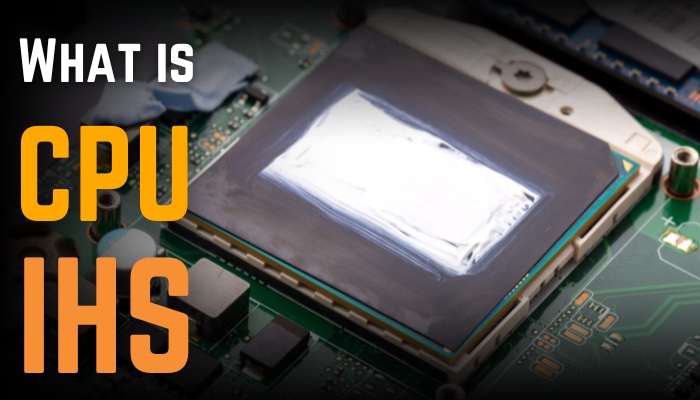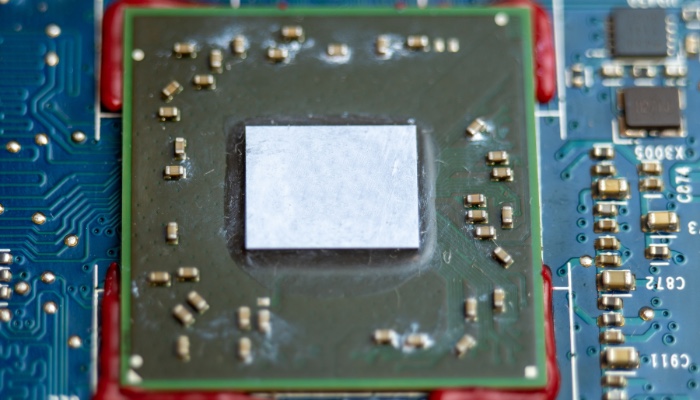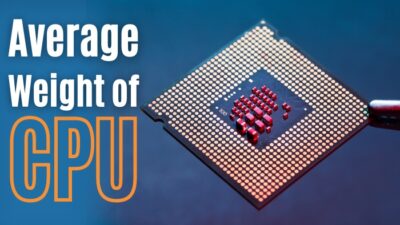Have you ever wondered about the objective of the shiny plate on a CPU?
It’s called IHS and is available on every AMD and Intel desktop processor. The IHS is a multipurpose CPU part, crucial for your processor’s safety and security.
In this article, I’ll explain the CPU IHS and tell its importance in your processor.
So, let’s begin.
What’s CPU IHS?
IHS stands for Integrated Heat Spreader. It is the outer cap of a CPU and is made of metal. It acts as a protective shell for the CPU die and a path for heat to dissipate from the fragile silicon to the surface and help conduct to the CPU cooler or heatsink.
IHS is present in every Intel and AMD desktop processor on the market. But do you know which metal is used to make it? It’s made of a solid copper plate and used as a surface to make contact between the heatsink or other thermal solution and the CPU.
Though copper has better heat conductivity, it is costlier than most metals. Also, some CPU IHS is made from copper alloy or nickel plated.
IHS is an essential part of a CPU, and the following passage will describe the importance of the integrated heat spreader.
Why Do CPUs Have an IHS?
 The CPU has an Integrated Heat Spreader (IHS) for exchanging heat between the CPU and the cooler. It also holds the processor components together and protects the delicate silicon underneath from cracks and external damage during the installation.
The CPU has an Integrated Heat Spreader (IHS) for exchanging heat between the CPU and the cooler. It also holds the processor components together and protects the delicate silicon underneath from cracks and external damage during the installation.
When the CPU gets hot, the die temperature increases significantly. Then the heat passes to the IHS, and the CPU cooler above it starts working. The integrated heat spreader is the only part that stays in the middle of the die and the cooler and works as a middleman.
Desktop processor is very fragile, and there are numerous possibilities for damaging the CPU components during the mounting process. Any incorrect or excessive mounting pressure can break apart the parts and cause a bad CPU.
The IHS endures the heavy pressure and protects the crucial components, especially the CPU die, from external damage.
However, when it comes to cooling, there is a question of whether the IHS is removable to ensure better heat dissipation. The passage below will tell if you can remove the IHS from the CPU.
Can I Remove & Use CPU Without IHS?
Yes, you can remove and use the CPU without integrated heat spreader (IHS). The process of removing the IHS is called Delidding. Taking off the outer metal cap may drop the temperature by a few degrees. It will conduct directly to the CPU cooler and increase efficiency.
You can use the CPU without IHS, but it’s recommended not to remove the IHS. It will void the warranty and can cause severe damage to your CPU.
Some serious overclockers use such methods to test or improve CPU performance. However, it’s a risky job, and there’s a lot of chance of losing the processor.
IHS gives protection to your CPU die and absorbs the pressure during installation. Without it, there’s an increasing possibility of breaking the die.
Though taking off the integrated heat spreader reduces the temperature of the die, it’s only a few degrees and negligible in the bigger picture.
Moreover, removing the heat isn’t the job of the CPU. It’s a task of the CPU cooler, and installing a better cooler can do the job for you.
Changing the thermal paste after a while is necessary to keep the conductivity good. You can clean the thermal paste of the CPU IHS and reapply it to ensure better heat dissipation.
Frequently Asked Questions
Do laptop CPUs have IHS?
No, laptop CPUs are soldered onto the motherboard, and there is no metal cap on the processor.
Can I use the CPU without IHS?
Yes, you can use the CPU without IHS. But it’s not recommended due to safety and warranty concerns.
What is CPU IHS made of?
The CPU IHS (Integrated Heat Spreader) is made of a solid copper plate and sometimes copper alloy or nickel plated.
Conclusion
The CPU IHS is vital for your processor’s heat emission and safety. You can use the CPU with or without the IHS, but keeping it will give you a similar outcome with better protection.
This article helped describe the IHS and its purpose and gave you a better understanding of it.
Share your thoughts in the comment box below, and I’ll catch you at the next one.
Cheers!




